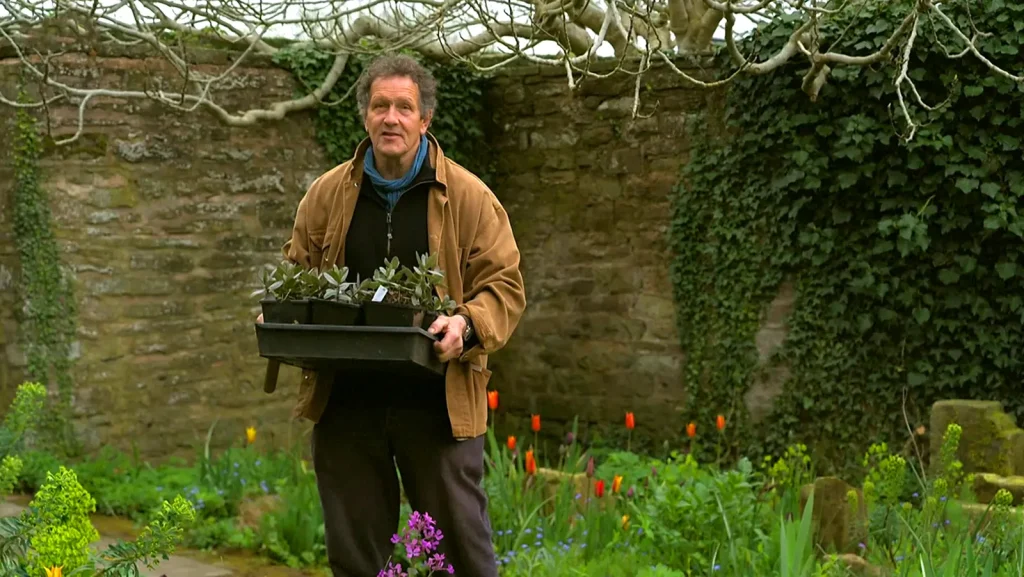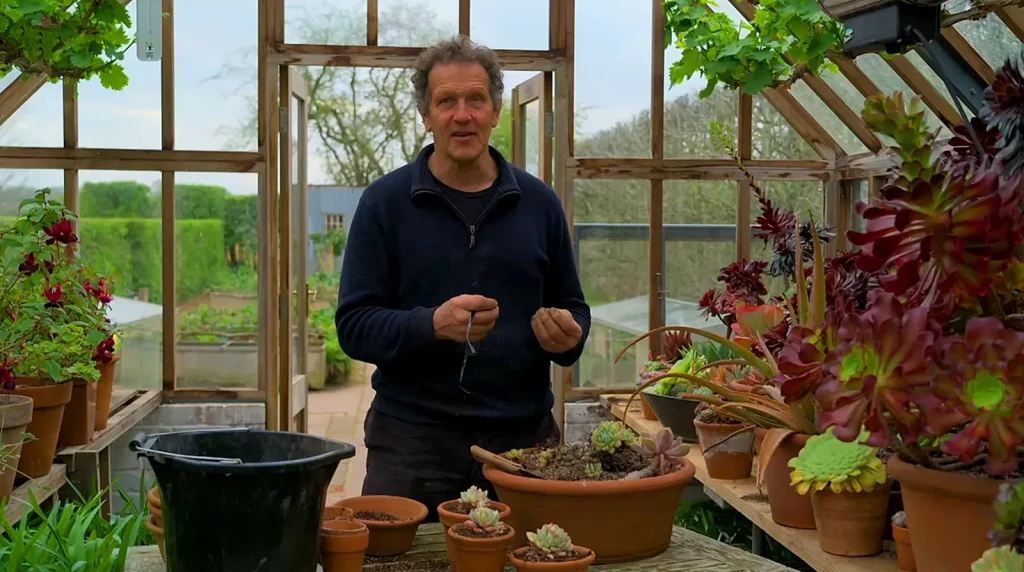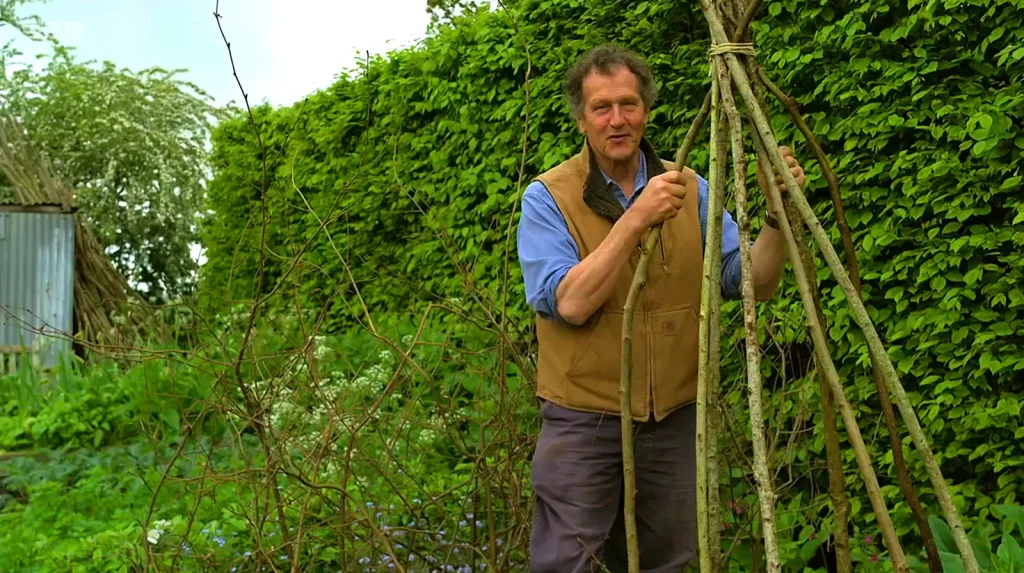Gardeners World 2024 Episode 21: Monty Don returns with expert advice on how to maintain vibrant and thriving summer borders well into the autumn season in this episode of Gardeners’ World. As the summer progresses, gaps may start appearing in your borders, but Monty shares his top recommendations for filling these spaces with an array of plants that not only extend the season’s beauty but also seamlessly transition your garden into the cooler months. With his extensive knowledge and passion for gardening, Monty demonstrates how to prune a species rose to encourage healthy growth and more prolific flowering in the future.
He also takes you step-by-step through the process of taking leaf cuttings from succulent plants, a valuable skill for anyone looking to propagate these hardy, drought-tolerant beauties. Additionally, Monty shows how to sow turnips, a quick-growing crop that can be harvested before the end of the summer, adding a delicious and nutritious element to your seasonal produce.
Beyond the borders, Monty gives an update on his sweetcorn, sharing insights into the plant’s progress and what to watch for as the ears mature. He also takes on the task of cutting back summer-fruiting raspberries, an essential job that helps to ensure a bountiful harvest next year. Monty’s practical tips are perfect for gardeners of all levels, whether you’re tending to a small backyard plot or a sprawling estate.
Meanwhile, Rachel de Thame takes us on a journey to Devon, where she explores a remarkable garden that has been transformed from a humble pig farm into a breathtakingly beautiful paradise. This garden, now a riot of color and life, is a testament to the transformative power of nature and the dedication of its owners. Rachel delves into the design and planting strategies that have turned this once utilitarian space into a haven for both people and wildlife. The garden’s unique features and plant choices offer inspiration for anyone looking to create a personal sanctuary filled with beauty and biodiversity.
In another segment, Frances Tophill embarks on a fascinating exploration of some of Britain’s most beloved garden plants, uncovering their surprising medicinal and homeopathic properties. From common herbs to flowering perennials, Frances reveals how these plants have been used for centuries to heal and nurture. Whether you’re interested in natural remedies or simply want to learn more about the plants growing in your garden, this segment offers a wealth of knowledge and inspiration.
Gardeners World 2024 Episode 21
The episode also introduces us to a creative gardener in Somerset who has found a new passion for building quirky and imaginative garden structures out of salvaged wood. His innovative designs add a touch of whimsy and character to the garden, proving that with a bit of creativity, recycled materials can be turned into something truly special. Whether it’s a rustic garden bench or a whimsical trellis, these structures not only serve a practical purpose but also enhance the garden’s overall aesthetic.
Finally, we meet a self-confessed orchid obsessive who proudly showcases his extensive collection of thousands of orchids. This segment offers a glimpse into the world of orchid cultivation, highlighting the dedication and expertise required to care for these exotic and often finicky plants. From rare species to stunning hybrids, the collection is a botanical treasure trove that will captivate any plant lover. The orchid enthusiast shares his tips and tricks for keeping these beautiful plants healthy and thriving, making this segment a must-watch for anyone interested in expanding their own collection or simply appreciating the beauty of these extraordinary flowers.
Gardeners’ World 2024 Episode 21 is packed with inspiration, practical advice, and a celebration of the creativity and passion that gardening brings to our lives. Whether you’re looking to enhance your summer borders, learn about the medicinal properties of plants, or simply enjoy the beauty of a well-tended garden, this episode offers something for every gardening enthusiast.
The Allure of Late Summer Gardens: A Colorful Spectacle
Introducing the Vibrant Cosmos ‘Double Click Rose’
As the warm days of late summer embrace our gardens, a true star emerges to captivate our senses. Enter the Cosmos ‘Double Click Rose’, a stunning annual that bursts onto the scene with its glorious double pink petals. This late-blooming beauty might test your patience, but rest assured, it’s worth every moment of anticipation.
Picture yourself strolling through your garden, the soft petals of the Cosmos brushing against your fingertips. The air is filled with a gentle fragrance, and the vibrant pink hues create a visual symphony that’s simply irresistible. It’s as if nature saved its best performance for the grand finale of summer, rewarding patient gardeners with a display that will continue to dazzle for months to come.
The Importance of Daily Deadheading for Prolonged Blooming
To keep this floral extravaganza in full swing, a little daily TLC goes a long way. Deadheading, the art of removing spent blooms, is the secret weapon in your gardening arsenal. Think of it as giving your Cosmos a gentle nudge to keep the party going. By snipping off faded flowers, you’re sending a clear message to your plants: “Keep blooming, darling!”
This simple yet effective technique isn’t just about aesthetics. It’s a clever way to trick your annuals into thinking their job isn’t done yet. Instead of shifting gears to produce seeds, they’ll continue pumping out those gorgeous blooms. It’s like hitting the refresh button on your garden, ensuring a constant supply of fresh, vibrant flowers well into the autumn months.
Creating a Diverse and Long-lasting Display with Complementary Plants
While the Cosmos ‘Double Click Rose’ is undoubtedly a showstopper, it truly shines when part of a carefully orchestrated ensemble. Imagine a garden where each plant plays its part in a harmonious symphony of colors, textures, and blooming periods. This is the key to creating a garden that remains captivating from the first signs of spring to the last whispers of autumn.
Consider pairing your Cosmos with the structural elegance of dahlias, the whimsical charm of sweet peas, and the airy grace of fennel. Add some roses for classic beauty and you’ve got a mix that’s both visually stunning and wonderfully diverse. Each plant brings its unique characteristics to the table, creating a tapestry of colors and forms that evolve throughout the seasons.
Remember, gardening is an art form where you’re the artist, and your plants are the palette. Don’t be afraid to experiment with different combinations. The joy of gardening lies in the process of creation, of watching your vision come to life in a riot of colors and textures. So go ahead, let your creativity bloom alongside your flowers!
Transforming Spaces: From Pig Farm to Planted Paradise
The Journey of Jennie and Jethro Marles: A 20-Year Garden Evolution
Imagine standing on a plot of land, surrounded by concrete slabs, asbestos-filled sheds, and slurry pits. It’s not exactly the stuff of gardening dreams, is it? Yet, this was precisely the challenge that Jennie and Jethro Marles embraced when they purchased an ex-pig farm in Devon back in 2002. Their vision? To transform this industrial wasteland into a horticultural haven.
Fast forward two decades, and the transformation is nothing short of miraculous. Where once stood utilitarian structures and industrial detritus, now unfolds a tapestry of lush gardens, each with its own unique character. The journey from pig farm to planted paradise wasn’t just about physical changes; it was a testament to patience, perseverance, and the power of nature to reclaim and beautify even the most unlikely spaces.
Incorporating Wildlife-Friendly Elements in Garden Design
From the outset, Jennie and Jethro had a clear goal: to create not just a beautiful garden, but a thriving ecosystem. They understood that a garden is more than just a collection of plants; it’s a living, breathing community. With this in mind, they set about incorporating elements that would attract and sustain wildlife.
The centerpiece of their wildlife-friendly approach was the creation of water features. As if by magic, the moment they dug out the first pond, nature responded. A duck appeared, followed closely by swans gliding up the stream. It was as if the local wildlife had been waiting in the wings, ready to make their grand entrance as soon as the stage was set. This immediate response from nature not only validated their approach but also provided immense satisfaction and motivation to continue their wildlife-friendly design.
The Art of Prairie Planting: Creating Natural-looking Borders
Inspired by the sweeping prairies of North America, Jennie and Jethro embraced the concept of prairie planting in their garden design. This style of gardening mimics the natural plant communities found in prairies, creating a look that’s both wild and carefully curated. The result? Long borders that flow with the grace of a summer breeze, filled with a diverse array of late-season perennials.
In these borders, you’ll find a carefully orchestrated symphony of plants. Echinacea provides soft pink hues, while sanguisorba adds touches of deep red. Phlomis and fennel repeat throughout the planting, creating a sense of rhythm and continuity. Tying it all together are soft, melding grasses like Molinia and Stipa gigantea, adding movement and texture to the overall composition. This approach not only creates a visually stunning display but also provides a haven for pollinators and other beneficial insects, further enhancing the garden’s ecological value.
Embracing Unique Garden Features: From Recycled Materials to Medicinal Plants
Nigel Palfrey’s Quirky Garden Structures: Upcycling with Creativity
Have you ever looked at an old gatepost or a discarded piece of wood and seen the potential for something extraordinary? That’s exactly what Nigel Palfrey does in his Somerset garden. With an artist’s eye and a craftsman’s skill, Nigel transforms salvaged materials into whimsical garden structures that capture the imagination and add character to his outdoor space.
Nigel’s creations are a testament to the power of creative reuse. Take, for instance, his crinkle-crankle folly. Inspired by a twisted branch, this serpentine structure winds through the garden, creating a magical pathway that feels like it’s straight out of a fantasy novel. It’s not just about aesthetics, though. Nigel’s structures often serve practical purposes too, providing homes for wildlife or creating unique spaces for relaxation and contemplation.
The Weleda Biodynamic Garden: Growing Plants for Herbal Remedies
Imagine a garden where every plant has a purpose beyond mere beauty. That’s precisely what you’ll find at the Weleda Biodynamic Garden in Derbyshire. This 13-acre site is a living pharmacy, where over 50 different medicinal plants are grown with meticulous care and attention. From the familiar calendula to the more exotic echinacea, each plant is cultivated with a specific healing purpose in mind.
But what sets this garden apart is its holistic approach to plant cultivation. Following biodynamic principles, the gardeners work in harmony with nature’s rhythms, creating a balanced ecosystem that supports the growth of these powerful medicinal plants. The result is a garden that not only produces high-quality herbs for remedies but also serves as a haven for biodiversity. It’s a place where the lines between gardening, medicine, and ecology blur, creating a unique and inspiring space.
Exploring the Medicinal Properties of Common Garden Plants
You might be surprised to learn that your garden is already home to a variety of plants with medicinal properties. That cheerful marigold (Calendula officinalis) brightening up your flower bed? It’s not just a pretty face. This versatile plant has been used for centuries to treat everything from skin irritations to digestive issues. Its vibrant orange petals are a clue to its high content of carotenoids, powerful antioxidants that support overall health.
But the healing potential of your garden doesn’t stop there. Even common herbs like thyme and rosemary pack a powerful medicinal punch. Thyme, with its aromatic leaves, has been used traditionally as an expectorant and antiseptic. Rosemary, meanwhile, is known for its ability to improve circulation and boost memory. By incorporating these plants into your garden, you’re not just creating a beautiful space, but a functional one too. It’s like having a natural first-aid kit right outside your door!
Conclusion of Gardeners World 2024 Episode 21: Embracing the Joy and Diversity of Gardening
The Wide Appeal of Gardening: From Specialized Collections to Casual Enjoyment
Gardening is a pursuit that welcomes all, from the passionate specialist to the casual weekend enthusiast. Consider Mark, the orchid aficionado, who tends to over 100,000 plants with meticulous care. His dedication to these exotic blooms is akin to an art form, each plant a masterpiece in his living gallery. On the other hand, there are those who simply revel in the act of nurturing their outdoor spaces, finding joy in the ever-changing tapestry of colors and textures.
This diversity is what makes gardening such a rich and rewarding hobby. Whether you’re cultivating rare species or simply enjoying the burst of color from a packet of wildflower seeds, there’s a place for you in the gardening world. The beauty lies in the fact that both approaches are equally valid and equally capable of bringing immense satisfaction. After all, the true essence of gardening isn’t about perfection, but about the journey of growth and discovery.
Encouraging Experimentation and Personal Expression in Garden Design
Your garden is your canvas, and you are the artist. Don’t be afraid to let your personality shine through in your garden design. Perhaps you’re drawn to the whimsical structures of Nigel Palfrey, crafting garden features from salvaged materials. Or maybe you’re inspired by the prairie-style planting of Jennie and Jethro Marles, creating sweeping borders of perennials and grasses. Whatever your style, embrace it!
Experimentation is key to finding what works for you and your space. Try different plant combinations, play with color schemes, or incorporate unexpected elements. Remember, there are no hard and fast rules in gardening. What matters most is that your garden brings you joy and reflects your unique vision. So go ahead, plant that exotic succulent next to your traditional roses, or create a mini wildlife habitat in a corner of your yard. Your garden is a living, evolving creation – let it grow and change with you.
Looking Ahead: Preparing Your Garden for the Changing Seasons
As we bid farewell to the vibrant displays of summer, it’s time to look ahead and prepare our gardens for the changing seasons. This transition offers new opportunities for creativity and enjoyment in our outdoor spaces. Start by assessing your garden’s current state. Which plants have thrived? Which might need to be relocated or replaced? This reflection can guide your plans for the coming year.
Consider planting some late-blooming varieties to extend the color in your garden well into autumn. Asters, chrysanthemums, and Japanese anemones are excellent choices for this. Don’t forget about the structural elements of your garden either. As leaves fall, the shapes of trees and shrubs become more prominent. This is a perfect time to add architectural interest with evergreens or plants with interesting bark or berries. By thinking ahead, you can ensure your garden remains a source of beauty and interest throughout the year, a constantly evolving canvas that reflects the changing rhythms of nature.
F.A.Q. Gardeners World 2024 Episode 21
Q.: What gardening tips does Monty Don offer in Gardeners’ World 2024 Episode 21?
A.: In Gardeners’ World 2024 Episode 21, Monty Don provides expert advice on maintaining vibrant summer borders as the season transitions into autumn. He shares his top recommendations for filling gaps in the garden with plants that extend the season’s beauty. Additionally, Monty demonstrates pruning techniques for a species rose to encourage healthy growth and more prolific flowering.
Q.: How does Monty Don suggest propagating succulent plants in this episode?
A.: Monty Don offers a step-by-step guide on taking leaf cuttings from succulent plants in Gardeners’ World 2024 Episode 21. This method is particularly valuable for gardeners looking to propagate these hardy, drought-tolerant plants, ensuring they can expand their collection efficiently.
Q.: What advice is given about planting turnips in Gardeners’ World 2024 Episode 21?
A.: Monty Don advises viewers on how to sow turnips, highlighting that this quick-growing crop can be harvested before the end of summer. This not only adds a nutritious element to your seasonal produce but also makes efficient use of garden space as the growing season progresses.
Q.: What unique garden transformations are featured in this episode?
A.: The episode showcases a remarkable transformation of a former pig farm in Devon into a stunning garden paradise. Rachel de Thame explores how the owners turned this once industrial space into a vibrant, wildlife-friendly garden filled with diverse plant life, offering inspiration for anyone looking to create their personal sanctuary.
Q.: Are there any segments on medicinal plants in Gardeners’ World 2024 Episode 21?
A.: Yes, Frances Tophill presents a segment that explores the medicinal and homeopathic properties of some of Britain’s most beloved garden plants. This segment delves into the historical uses of these plants for healing purposes, offering a wealth of knowledge for gardeners interested in natural remedies.




